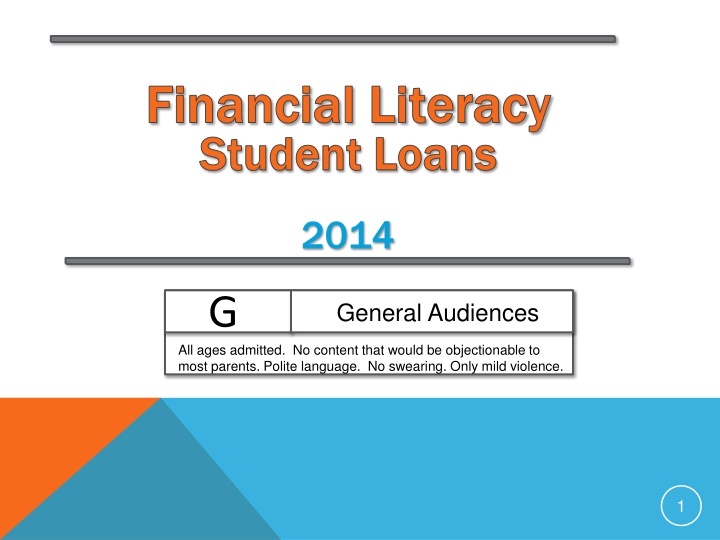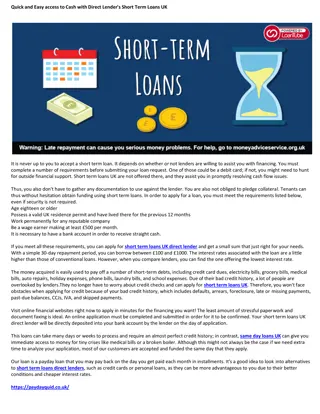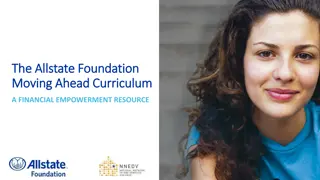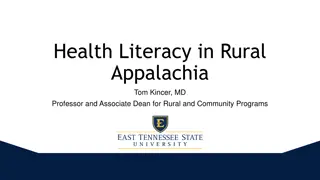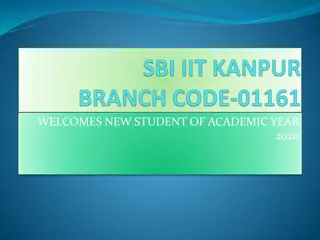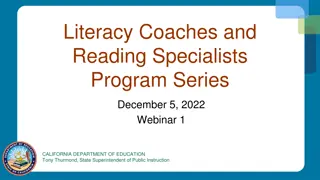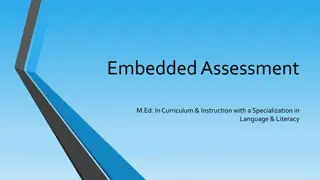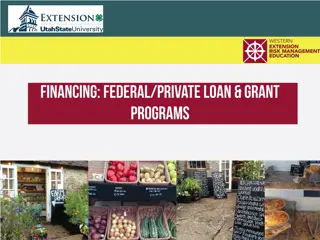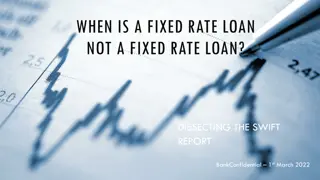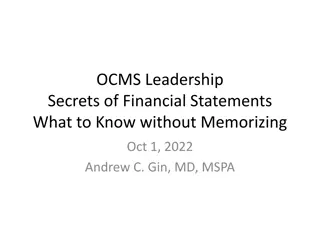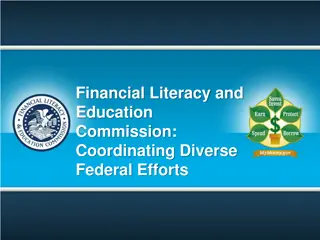Student Loans and Financial Literacy in 2014
Explore the world of student loans, financial aid terminology, federal loans, and the background of educational debt in the US. Learn about the lifecycle of Direct Loans and their eligibility criteria, from FAFSA to disbursement, to navigate the complexities of financing higher education.
Download Presentation

Please find below an Image/Link to download the presentation.
The content on the website is provided AS IS for your information and personal use only. It may not be sold, licensed, or shared on other websites without obtaining consent from the author.If you encounter any issues during the download, it is possible that the publisher has removed the file from their server.
You are allowed to download the files provided on this website for personal or commercial use, subject to the condition that they are used lawfully. All files are the property of their respective owners.
The content on the website is provided AS IS for your information and personal use only. It may not be sold, licensed, or shared on other websites without obtaining consent from the author.
E N D
Presentation Transcript
Financial Literacy Financial Literacy Student Loans Student Loans 2014 G General Audiences All ages admitted. No content that would be objectionable to most parents. Polite language. No swearing. Only mild violence. 1
STUDENT LOANS Tiffany Galbavy & Shane Sangrey Director Financial Aid Dean of Academics Program Coordinator 3
Terminology Terminology Free Application for Federal Student Aid = FAFSA Cost of Attendance = The student's Cost Of Attendance includes tuition, fees, and standard allocation designed to cover reasonable living expenses while attending school. The cost of attendance is determined by the school using guidelines established by federal regulations. (also known as Cost of Education or Student Budget) FAO = Financial Aid Office Unmet need Unmet need: Any need that remains after aid has been awarded. 4
Federal Loans Federal Loans 5
Background Background On January 1, 2011, total US educational debt stood at $1.08 trillion. The average cost of a Bachelor s degree at a private college or university is $45,000, according to The College Board s Trends in Higher Education. Of the nearly 20 million Americans who attend college each year, about 12 million borrow, according to the Almanac of Higher Education. Estimates show that the average four-year graduate accumulates $26,000 to $29,000 in loans, and some leave college with debt totaling in the six figures. 6
Lifecycle of a Direct Loan Lifecycle of a Direct Loan Eligibility Eligibility Determined by combining: Information & awards from FAFSA Other awards & payments Limited by the Cost of Attendance 7
Lifecycle of a Direct Loan Lifecycle of a Direct Loan Eligibility Eligibility DLs are sent to the Dept. of Ed. Origination Origination 8
Lifecycle of a Direct Loan Lifecycle of a Direct Loan Eligibility Eligibility Funds transmit from DoEd to school on appointed disbursement day Origination Origination Disbursement Disbursement 9
Lifecycle of a Direct Loan Lifecycle of a Direct Loan Eligibility Eligibility Repayment Repayment Origination Origination Disbursement Disbursement 10
LOAN COUNSELING www.studentloans.gov www.studentloans.gov Entrance Counseling Entrance Counseling First-time borrowers Inform them of their rights and responsibilities of taking out this loan www.nslds.ed.gov www.nslds.ed.gov Exit Counseling Exit Counseling All loan recipients that depart from your institution Graduate, withdraw, transfer, do not return No Exit Counseling = no transcripts / no diploma 11
PROMISSORY NOTE Document executed by borrower, which spells Document executed by borrower, which spells out the terms & conditions of the loan out the terms & conditions of the loan disbursements, use and repayment disbursements, use and repayment If the note is for multiple loan periods and If the note is for multiple loan periods and varying amounts, the lender may elect to have the varying amounts, the lender may elect to have the borrower use a: borrower use a: Master Promissory Note Master Promissory Note 12
FEDERAL PERKINS LOAN Oldest active educational loan Oldest active educational loan Institution administers this loan Institution administers this loan Previous allocations came from the Dept of Previous allocations came from the Dept of Ed, now schools operate this loan from Ed, now schools operate this loan from repaid funds funds Fixed 5% interest rate Fixed 5% interest rate Repayment begins 9 months after student Repayment begins 9 months after student ceases to be enrolled at least 1/2 time ceases to be enrolled at least 1/2 time Minimum payment as low as $30 Minimum payment as low as $30 Maximum repayment term is 10 years Maximum repayment term is 10 years repaid 14
FEDERAL PARENT PLUS LOAN Federal PLUS Loan is a loan for parents of dependent Federal PLUS Loan is a loan for parents of dependent students students Parent borrower is fully liable for loan Parent borrower is fully liable for loan (may require endorser) (may require endorser) FAFSA not required by regulation, but schools can FAFSA not required by regulation, but schools can it if they wish it if they wish Eligibility Eligibility Parent must be the natural or adoptive parent of the student, or spouse of one of those people require require Parent must be a US Citizen, U.S. National or eligible NC Parent must have no Title IV loans in default Parent must be credit worthy, or have credit worthy endorser 15
FEDERAL GRADUATE PLUS LOAN Eligibility (ref. FSA Handbook) Eligibility (ref. FSA Handbook) Borrower must complete a FAFSA U.S. Citizen attending at least half-time, seeking a Graduate or Professional degree Borrower must pass a credit evaluation Loan Limits Loan Limits COA minus other aid 16
FEDERAL DIRECT LOAN U.S. Citizen, U.S. National, permanent US U.S. Citizen, U.S. National, permanent US Residents & aliens, or Eligible non Residents & aliens, or Eligible non- -citizen (ref. FSA Handbook) (ref. FSA Handbook) Enroll 1/2 time in a degree seeking program Enroll 1/2 time in a degree seeking program SAP SAP - - Satisfactory Academic Progress Satisfactory Academic Progress No default / overpayment on any Aid No default / overpayment on any Aid Register with selective service Register with selective service Must complete FAFSA Must complete FAFSA citizen 17
DIRECT LOANS: SUB VS. UNSUB Subsidized DL Subsidized DL ( (Need Need- -based) based) Interest: Interest: ED pays during ED pays during In-school Grace Deferment Student pays during Student pays during Repayment Unsubsidized DL Unsubsidized DL ( (Non need Non need- -based) based) Interest: Interest: Student responsible for Student responsible for all all Can be capitalized, or Student can choose to pay interest 18
NEED VS NON-NEED Need Need- -based based Financial Aid Financial Aid Scholarships State & Federal Grants Subsidized DLs Non Non- -Need Financial Aid Need Financial Aid Unsubsidized DLs Private Loans 19
DL LOAN LIMITS Combined Sub & Unsub $31,000 Sub may not exceed Undergrad Dependent *Undergrad Independent $23,000 $57,500 $23,000 Grad and Professional $138,500 $65,500 * * And dependent student whose parent is unable to obtain a PLUS loan; denial of parent s PLUS produces add l unsub 20
INTEREST RATES & FEES Perkins Loans no fees Fixed IR = 5% Direct Loans 0.5% orig. fee Actually 1.5% minus 1% rebate) Undergrad sub = fixed IR of 4.5% All other DLs = fixed IR of 6.8% Direct Parent PLUS / Grad PLUS 2.5% orig Actually 1.5% minus 1% rebate) fixed IR 7.9% To retain rebates,1st 12 pymts must be on time 21
FEDERAL CONSOLIDATION LOAN Federal education loans that may be consolidated Federal education loans that may be consolidated FFELP (Federal Family Ed Loan. Perkins Direct HEAL (Health Education Ass. Loan) No minimum loan amount No minimum loan amount Thirty Thirty- -year repayment (maximum) year repayment (maximum) Interest rate will be a fixed interest rate, capped at Interest rate will be a fixed interest rate, capped at 8.25% 8.25% A weighted average is used to figure the interest rate A weighted average is used to figure the interest rate and then it is rounded up to the nearest 1/8 of a and then it is rounded up to the nearest 1/8 of a percent. percent. 22
REPAYMENT OF FEDERAL LOANS DL DL Enters at end of grace period (6 months after student graduates or drops below half-time) Parent PLUS loan Parent PLUS loan Enters repayment 60 days after full disbursement (parent can request deferment while student is enrolled at least half-time and during six months following that up to 25 years to repay) Grad PLUS loan Grad PLUS loan Enters when borrower falls below halftime enrollment 24
REPAYMENT OF FEDERAL LOANS All federal loans All federal loans Keep loan holders current on student borrower contact information Contact loan holders as quickly as possible, if a single missed payment is anticipated Contact loan holders if payments cannot be made Change in your financial circumstances Loss of job Pay off loans as quickly as possible Pay off loans as quickly as possible 25
REPAYMENT OF FEDERAL LOANS Single information source for all federal Single information source for all federal loans loans loan holder info, amounts owed loan holder info, amounts owed including interest accrual including interest accrual www.nslds.ed.gov www.nslds.ed.gov 26
WAYS TO REPAY FEDERAL LOANS Standard Standard Monthly payment remains consistent for 10 years Monthly payment remains consistent for 10 years Graduated Graduated Monthly payments are lower at first but then Monthly payments are lower at first but then increase every 2 years over the 30 increase every 2 years over the 30 yr yr repayment term Income Income- -sensitive sensitive Monthly payments are based on your Monthly payments are based on your monthly gross income monthly gross income Extended Extended Monthly payments over a 25 year plan. Must have a debt Monthly payments over a 25 year plan. Must have a debt greater than $30,000 greater than $30,000 Income Contingent Income Contingent payments based on annual calculations and payments based on annual calculations and adjusted so as not to cause undue hardship ; adjusted so as not to cause undue hardship ; (25 yr. forgiveness) (25 yr. forgiveness) Income Based Plan Income Based Plan - - Monthly payments will not exceed 15% of Monthly payments will not exceed 15% of the amount by which your adjusted gross income exceeds 150% of the amount by which your adjusted gross income exceeds 150% of the poverty line for your family size. (25 poverty line for your family size. (25 yr yr forgiveness) repayment term the forgiveness) 27
DEFERMENTS Period of postponing payments Period of postponing payments Federal government will pay interest for the borrower on Subsidized DL Federal government will pay interest for the borrower on Subsidized DL Entitlement Entitlement Some possible deferments: Some possible deferments: - - Education Education - - Peace Corps/ Public Service/ Military Peace Corps/ Public Service/ Military - - Economic Hardship Economic Hardship 28
FORBEARANCES Temporary cessation, reduction, or extension of Temporary cessation, reduction, or extension of payments payments Student is responsible for Student is responsible for interest that accrues Borrower is willing but temporarily unable to pay Borrower is willing but temporarily unable to pay interest that accrues 29
DEFAULT Failure to pay back student loan Failure to pay back student loan Student is considered in default after being Student is considered in default after being delinquent for 270 days; lender may file days; lender may file claim as early as day 271 claim as early as day 271 delinquent for 270 Student is susceptible to wage garnishment, seizure of income Student is susceptible to wage garnishment, seizure of income tax refunds, lottery winnings, license non tax refunds, lottery winnings, license non- -renewal, sued by DOE renewal, sued by DOE Student not eligible for fed. financial aid; 7 Student not eligible for fed. financial aid; 7- -year damage to student credit history student credit history Bankruptcy? Student loans are not exempt from you claiming Bankruptcy? Student loans are not exempt from you claiming bankruptcy. You must pay it back. bankruptcy. You must pay it back. year damage to 30
PRIVATE (ALTERNATIVE) LOANS Designed to bridge the gap between other aid Designed to bridge the gap between other aid and total college costs and total college costs Interest rates from 5% Interest rates from 5% - - 18% Origination and repayment fees vary Origination and repayment fees vary Co Co- -borrower requirements (underwriting) borrower requirements (underwriting) Most now school Most now school- -certified (lower repayment certified (lower repayment risk) risk) Self Self- -Certification Form Certification Form 18% 31
Lifecycle of a PVT Loan Lifecycle of a PVT Loan Eligibility Eligibility Private Loan process is a bit more complicated & time consuming Origination Origination 32
Lifecycle of a Direct Loan Lifecycle of a Direct Loan Eligibility Eligibility Funds transmit from private lender to school on appointed disbursement day Origination Origination Disbursement Disbursement 33
Lifecycle of a Direct Loan Lifecycle of a Direct Loan Eligibility Eligibility Repayment Repayment Origination Origination Disbursement Disbursement 34
REPAYMENT OF PRIVATE LOANS Keep loan holders current on student borrower contact information Contact loan holders as quickly as possible, if a single missed payment is anticipated Contact loan holders if payments cannot be made Change in your financial circumstances Loss of job Pay off loans as quickly as possible Pay off loans as quickly as possible 35
RESOURCES FAFSA.ed.gov FAFSA.ed.gov Federal Student Aid ( Federal Student Aid (studentaid.ed.gov studentaid.ed.gov) ) Student Loan Borrower Assistance Project ( Student Loan Borrower Assistance Project (www.studentloanborrowerassistance.org www.studentloanborrowerassistance.org) ) Federal Student Loan Consolidation ( Federal Student Loan Consolidation (loanconsolidation.ed.gov loanconsolidation.ed.gov) ) US Department of Education s Debt Collection Service US Department of Education s Debt Collection Service ( (www.ed.gov/offices/OSFAP/DCS www.ed.gov/offices/OSFAP/DCS) ) FSA Ombudsman ( FSA Ombudsman (www.ombudsman.ed.gov www.ombudsman.ed.gov) ) PSL Ombudsman ( PSL Ombudsman (www.consumerfinance.gov www.consumerfinance.gov) )
MOST IMPORTANT THING TO REMEMBER!!! -APPLY FOR SCHOLARSHIPS TO AVOID LOANS!!!!!!!!!
QUESTIONS ??????? Tiffany or Shane 38
